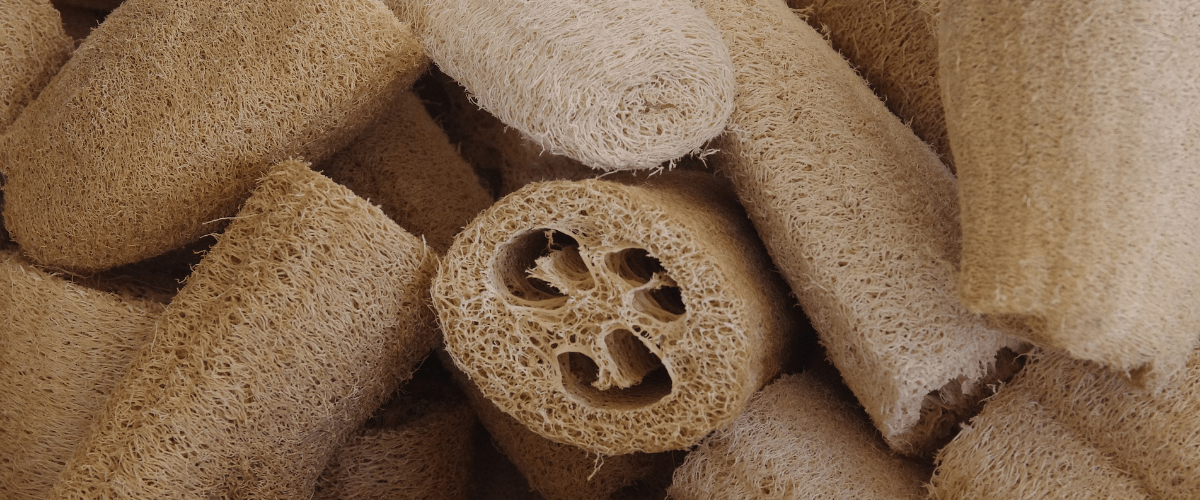Most people probably know what a Loofah is. You might have even owned one. But did you know that they’re a vegetable? Even better: they’re something you can grow yourself! Here’s everything you need to know.
As it turns out, Loofahs, sometimes called loopha or Luffa, is a type of gourd in the cucumber family. The fruit, while edible, can be left to over-ripen. After a point, they will naturally dry themselves out entirely. After they do, you can harvest them, peel the skin off, and use the inside as a natural sponge material.
I had learned about this from my brother, who told me our mother asked him to grow some. Once I had wrapped my mind around the idea that those bath sponges were veggies this whole time, I realized that it would be an ideal addition to my ongoing collection of ways to self produce anything you could ever need.
There are actually two kinds of luffa plants that people grow. The first is the Luffa Aegyptiaca and Luffa Cyclindrica. One has more of a ridged fruit shape, while the other is smoother. Generally speaking, both types can be used interchangeably. The seeds are a bit uncommon, so you may need to buy them online instead of at a local store.
No products found.
How to Plant and Grow Luffa
Luffa is a full sun style plant. It prefers well draining soil that stays moist. They get rather long, with vines reaching up to 30 feet sometimes. For that reason, either allow it plenty of room to spread or a sturdy trellis to climb.
They take a long time to grow to fruition, as many as 200 warm days. In some colder regions, it’s not uncommon to start the seeds indoors. (We wrote about that recently). They don’t transplant amazingly well, so sow the seeds outside if you live somewhere warm enough.
Keep warm and moist all season long. They will bloom yellow flowers, which will grow into the gourds. They start small, pencil sized, and grow larger as you go. If you want to eat them, you can pick them while the flesh is a dark green color.
How to Harvest and Prepare Luffa Sponges
If you want the sponges however, you let them ripen longer. Too long, even. The gourds will naturally dry themselves out and form a fibrous interior. You can tell when this happens because the outer skin becomes a dark yellow or brown color. They will also feel lighter as the moisture inside goes away. The ideal stage is when the outer skin starts to crack, but this won’t always happen.
When ready, remove the gourd from the stem with sharp scissors. If the skin is cracked, peel it away. If it isn’t, gently squeeze until it does crack, then peel it away.
Once the skin is removed, you can shake out the seeds out from inside. Dry the seeds and save them, that way you can plant another one next season.
The inner sponge material won’t be clean right out the bat. There will be some sap remaining. This can easily be washed out with water and a small bit of soap. If the color is uneven and you dont like that, you can soak it in non-chlorine bleach. But for a more natural style, leave as is.
Dry out the washed and clean sponges, preferably in the sunlight. Be sure to rotate them to ensure full coverage. You can also string them up to be free floating. Leave there until completely dry.
Tada! You’re done. You can leave them as large sponges, cut them into squares, or slice them into discs, whatever you prefer. Now you have plenty of sponges for exfoliating skin, washing dishes, or whatever you need.
Proper Loofah Storage and Care
There is one downside to using a loofah. They are more prone to developing bacteria. All of their nooks and pores means they can easily retain dead cells and other unhealthy material. If you dont want your loofah to stink and promote infections, you need to take proper care of it.
- When not in use, store in a dry, aerated place.
- After using, be it dishes or showers, thoroughly rinse it out after with clean water.
- Allow it to dry completely between uses.
- Throw out after at most a month of use.
- To prolong life, soak in a 5% bleach solution once a week or so.
It is commonly recommended to NOT keep your loofah in the bathroom after showering. But that if you do, you should make sure the room is well ventilated to ensure moisture is removed.
For washing dishes, we like to throw the loofah in with the dishwasher before running it. The surge or sanitary hot water and soap will help clean it.
For showers and baths, we like to treat our loofahs like towels: cycle through a small collection of them, running them through the washer and drying when they need cleaned.
Most importantly, just throw the loofah away when it gets too gross or dirty. What’s the point of doing all of this if you’re just going to get sick from using them for too long?

